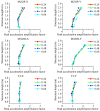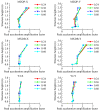Shaking Table Test of a Transfer-Purge Chamber in Nuclear Island Structure
- PMID: 35160712
- PMCID: PMC8837027
- DOI: 10.3390/ma15030766
Shaking Table Test of a Transfer-Purge Chamber in Nuclear Island Structure
Abstract
The transfer-purge chamber is an operation room for nuclear fuel transport and purging in a nuclear power plant, which has a demand for structural reliability and radiation protection. The transfer-purge chamber has features such as large curvature, heavy concrete, long overhang, and irregular cross-sections, and it is constructed of double steel plates reinforced concrete (SC) structure. This study performed shaking table tests for a 1:4.5 scale model of the transfer-purge chamber. Three sets of ground motions were input in the scale model in the horizontal and vertical directions to study its structural reliability and seismic performance. Acceleration response and strain response of the structure were analyzed to evaluate the dynamic characteristics of the transfer-purge chamber under the ground motion. The results show that the transfer-purge chamber has great stiffness and short periods. The periods slightly increase with the rise of intensity of seismic ground motions. Under the excitation of ground motions, the dynamic response of the transfer-purge chamber is slight. No obvious deformation or damage occurred on the transfer-purge chamber, and cracking in concrete or buckling on steel plate did not appear. The transfer-purge chamber has excellent seismic performance, and it is sufficiently safe and reliable from a structural perspective.
Keywords: double steel plates reinforced concrete structure; nuclear power plant; seismic performance; shaking table test; transfer-purge chamber.
Conflict of interest statement
The authors declare no conflict of interest.
Figures




















Similar articles
-
Temperature Field and Stress Analysis of the Heavy-Concrete Transfer-Purge Chamber of the Nuclear Power Plant.Materials (Basel). 2023 Jan 9;16(2):613. doi: 10.3390/ma16020613. Materials (Basel). 2023. PMID: 36676350 Free PMC article.
-
Shaking table test on seismic performance of a large-span high-rise building.Sci Rep. 2024 Mar 19;14(1):6580. doi: 10.1038/s41598-024-57068-0. Sci Rep. 2024. PMID: 38504108 Free PMC article.
-
Reliability Analysis of Reinforced Concrete Structure with Shock Absorber Damper under Pseudo-Dynamic Loads.Materials (Basel). 2022 Apr 6;15(7):2688. doi: 10.3390/ma15072688. Materials (Basel). 2022. PMID: 35408021 Free PMC article.
-
Pseudo-Dynamic Test on Composite Frame with Steel-Reinforced Recycled Concrete Columns and Steel Beams.Materials (Basel). 2022 Sep 13;15(18):6355. doi: 10.3390/ma15186355. Materials (Basel). 2022. PMID: 36143663 Free PMC article.
-
Development and present status of seismic evaluation and seismic retrofit of existing reinforced concrete buildings in Japan.Proc Jpn Acad Ser B Phys Biol Sci. 2021;97(7):402-422. doi: 10.2183/pjab.97.021. Proc Jpn Acad Ser B Phys Biol Sci. 2021. PMID: 34380916 Free PMC article. Review.
Cited by
-
Temperature Field and Stress Analysis of the Heavy-Concrete Transfer-Purge Chamber of the Nuclear Power Plant.Materials (Basel). 2023 Jan 9;16(2):613. doi: 10.3390/ma16020613. Materials (Basel). 2023. PMID: 36676350 Free PMC article.
References
-
- Zhao Q., Astaneh-Asl A. Cyclic Behavior of Traditional and Innovative Composite Shear Walls. J. Struct. Eng. 2004;130:271–284. doi: 10.1061/(ASCE)0733-9445(2004)130:2(271). - DOI
-
- Guo L., Li R., Rong Q., Zhang S. Cyclic behavior of SPSW and CSPSW in composite frame. Thin-Walled Struct. 2012;51:39–52. doi: 10.1016/j.tws.2011.10.014. - DOI
-
- Wright H., Gallocher S. The behaviour of composite walling under construction and service loading. J. Constr. Steel Res. 1995;35:257–273. doi: 10.1016/0143-974X(94)00051-I. - DOI
-
- Wright H. The axial load behaviour of composite walling. J. Constr. Steel Res. 1998;45:353–375. doi: 10.1016/S0143-974X(97)00030-8. - DOI
-
- Akiyama H., Sekimoto H., Tanaka M., Inoue K., Fukihara M., Okuda Y. 1/10th scale model test of inner concrete structure composed of concrete filled steel bearing wall; Proceedings of the Transactions of the 10th International Conference on Structural Mechanics in Reactor Technology (SMiRT-10); Raleigh, NC, USA. 22–27 August 1989; pp. 73–78.
Grants and funding
LinkOut - more resources
Full Text Sources

